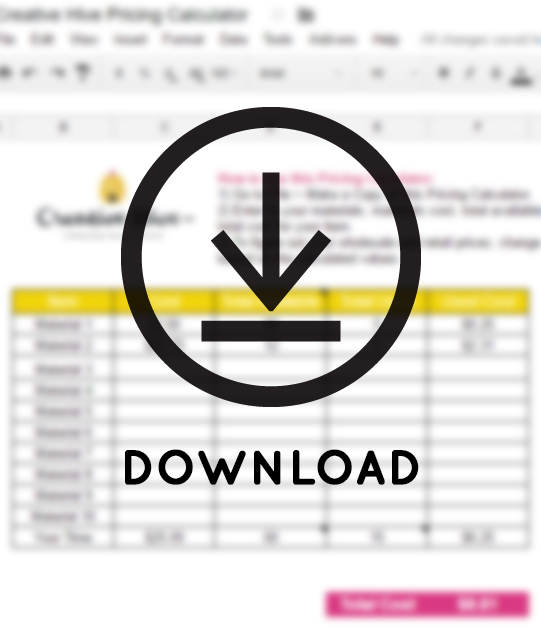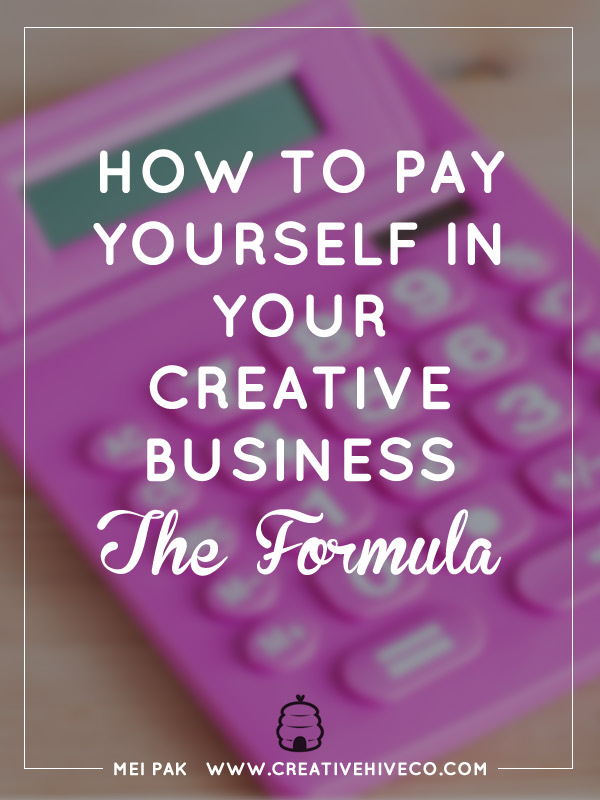I want to help you build a sustainable, profitable handmade business that makes you consistent income and sales. I only ever teach or recommend marketing, social media, pricing, production and branding tips that I’ve personally used successfully in my own 7-figure handmade businesses.
I'm Mei, from Los Angeles!
Read More
Popular Posts You'll Love
Looking for something?
Categories
starting a business
get more traffic
running a business
make more sales
branding
growing a business
mindset & productivity
podcasts
pricing & money
product photography
reviews
selling on etsy
selling on amazon
social media
selling wholesale
- Facebook435
- Twitter34
- Pinterest34.3K
- 34.7Kshares
You are depriving yourself
Hey small business owner. I’m calling you out.
You’re in big trouble.
Money matters are not to be taken lightly in your business.
For example, pricing your products correctly is the foundation of your career.
I bet all the chocolate in the house that you’re making this money mistake.
You’re depriving yourself (and your family) of your business profits.
In other words, you’re probably not cutting yourself a check at the end of every month.
In this post, you’ll find out why this is super important to do and the formula for how to do it.
Why you should pay yourself
Separate business money from personal money
If you’re making business expenses using money from the same bank account/credit card that you use to spend on groceries, stop it right now.
Business expenses should not be mixed in with expenses for your home, self or family.
Start a separate checking account for your business. This will help tons during tax time.
Doing this simple task will flip a switch in your head and you’ll start taking your business a lot more seriously too.
Set up your bank account with some capital so you have something to start with!
Treat yo’self (be a good boss)
I know you love making products to sell in your business.
But soon, you’ll start to experience burnout because you’re a workaholic (that’s in our creative business owner genes).
Isn’t it time you treated yourself to something you liked – that wasn’t related to work?
Start a garden.
Take a yoga class.
Go to the mall.
Doing things costs money – and these treat yo’self activities should come out of your personal bank account.
So be sure you’re paying yourself every two weeks or at the end of the month, so you can reap the rewards of owning your own business.
Take care of yourself, just like a good boss would.
Save for your future
That car you need replaced?
That kitchen remodeling you’ve been dreaming of?
Your vacation to Hawaii?
Your kids’ college fund?
Your 401k?
You guessed it, these are all expenses you need to pay with your personal money, not business.
Where is all this personal money coming from, if not from regular paychecks to yourself from your own business?
The Formula
This is super simple (if you know how to do simple arithmetic with a calculator) but so many creatives omit this in their lives.
Let’s start by reviewing our pricing formula:
Supplies + Your Time = Item Cost
Item Cost x 2.2 = Wholesale Price
Wholesale Price x 2.2 = Retail Price
It’s easy to fall into the trap in thinking the 2.2x markup in your pricing formula is what you pay yourself with.
[yellowbox]Bonus: [thrive_2step id=’5182′]Download my FREE and easy plug-and-play pricing calculator[/thrive_2step] to figure out what to price your items under a minute without any math![/yellowbox]That markup stays in your business until you pay yourself, using this formula:
Revenue – Expenses = Profit (or Loss)
70% Profit = Your Paycheck
30% Profit = Your Taxes
The percentages are variable and can be tweaked to your business and life.
For example, say you wanted to save some Profit in the business for a cool new laser printer. You could then try:
Revenue – Expenses = Profit (or Loss)
60% Profit = Your Paycheck
30% Profit = Your Taxes
10% Profit = Reinvest into the business
30% for taxes is what I’ve found to work for me and my life, however it is an estimate.
After several years of doing taxes, 30% is about how much I end up paying every year including federal, state and self employment taxes.
Let’s do an example:
Revenue this month ($1,000) – Expenses this month ($500) = $500 Profit (yay!)
70% Profit ($500) = Your Paycheck ($350)
30% Profit ($500) = Your Taxes ($150)
Now for the moment of glory:
Write yourself a check for $350.
Take Action
Every two weeks or at the end of every month, make it part of your routine to figure out your monthly revenue and expenses for your business.
If you don’t make a profit every month, that’s OK.
It’s a good reminder to look at your business as a business and keep doing things that make you money.
So take action now: write this formula down in your journal or print it out and tape it on your computer so you don’t forget.
Download my FREE and easy plug-and-play pricing calculator to figure out what to price your items under a minute without any math:
[thrive_2step id=’5182′] [/thrive_2step]
[/thrive_2step]

Leave a Comment
Liked this article? Share it!
Unlock a Profitable Handmade Business
in Just 12 Weeks Without Using Etsy
or Social Media
FREE WORKSHOP
This workshop is for anyone who makes and sells a handmade or physical product, including jewelry designers, artists, paper designers, bath & body product makers and more!
What You'll Discover
The #1 mistake people make with Etsy & social media that causes shops to FLOP
The secret to making it with your handmade shop so it's no longer just a hobby
How to make sales in your handmade shop with ease so you can finally get to 6-figures
TAKE ME THERE
Your email address will not be published. Required fields are marked *
Leave a Reply Cancel reply
About
Blog
A Sale A Day
Student Login
Free Class
Contact
Terms
Become A Student
Watch On YouTube
Student Reviews
See My Handmade Shop!



Mei! What a great article and wonderful way to break down a complex concept and make it easy to understand. It’s far too easy to fall into the trap of doing your craft for the love of the craft and not reaping the financial rewards. Well done! Will definitely share this with my network. :-)
Thanks so much Jenn! Glad this resonated with you.
I am glad I came across your post! Important, useful information simply put. I think I finally have a clear understanding of the numbers (now I need to make some money).
Thanks!
Thanks for stopping by Susan! And no problem. There are tons of free articles in here to help you make money :-)
Nice workable formula. One basic question though, with the very first formula for pricing: ” Supplies+Your Time=Item cost. What do you mean ” Your Time” ?….. Is there a dollar value attached to ” Your Time” ? Surely you don’t mean $30 for supplies + 6 hrs of your time=Item Cost.~~~How do you account for: Degree/Quality of workmanship, Artistic value, Marketability Value of the Art Piece?????
Hi Lynn!
I do mean that exactly. You need to decide what hourly rate you want to pay for your labor if you’re making your own products. If you’re charging $25/hour, then 6 hours of your time would add $150 to your Item Cost.
You can account for your education/background, quality/workmanship, artistic value, demand in the marketplace with the markups that I mentioned. Charge higher markups where you see fit, you don’t need to limit yourself to 2.5 markup.
[…] give themself a paycheck from their Etsy sales, anyway? It’s tough! Mei at Creative Hive Co covers all the basics and gives a pretty good argument for implementing this method […]
Today is my first day of being a full time business owner, I left my job Friday and I am freaking out a little. This is a great post to get me more prepared. Thanks.
Hey Veronica! Congratulations on that huge new chapter in your life! That scary feeling will never truly go away. Unfortunately that’s our curse of being self employed but there are definitely things we can do to promote stability and consistency in our business. Thanks for dropping by. Congrats again!
This post was nothing short of amazing! I love love LOVE numbers, although I’m creative entrepreneur, I still have accounting and taxes to take care of. I actually love this formula! I had a different system but this is much more simplier! Thanks for a great post!
Hey Natalie! I luuurve numbers too. High five! I’m curious to hear what formula you were using before! Can you share?
What a helpful post! I’m still in the pre-planning trenches and this is going to be the biggest help in nailing down my financial goals. Better yet, you’ve explained it so incredibly simply! Thanks so much for posting this!
Hi
I stumbled upon this article, and I’m so glad I did. I stopped treating my business as a hobby, and got serious with my craft. This article was just what I needed on how to pay myself.
It was not complicated and straight to the point, but I do have a question. You mention the things we should be paying from our personal account, but when we set aside the .30% for taxes, should we pay that from our business account? or do I put that amount in a separate account until tax time?. Also, what about donations to your local church? I know I can itemized those donations given through out the year, but should I do that from personal account, or my business account?
Thanks,
Diahann
Hi Diahann!
I’m glad the formula helped!
When you set aside the 30% tax money (again, this % will depend on you and may be different) it needs to be paid from our business account. You should be filing taxes quarterly, but what I like to do with the money in the meantime is put it in Betterment (https://www.betterment.com/)which invests your money in mutual funds, stocks and bonds so you’re collecting a bit of interest over the three months. Separating the tax money every month like this also ensures that I don’t spend it!
Now, I’m not a CPA or a lawyer, but I believe charitable donations depend on the purpose. If you’re donating old clothes, that ties in with your personal account. But if you’re donating product from your business (like for a fundraiser) then it should be deductible from your business account.
Hope that helps!
Thank you so much for a wonderful article. I am not sure if I can apply this to my business yet. I started last year but still in loss. Cost of setting up and buying materials is way too much and I am not sure if I would be able to get any profit selling a $5 card. By no means I would be able to pay myself. Ifi would be able to make some profit it would be so good at this stage.
My business is mostly custom work. The client brings me most of the supplies (quilt top, batting and backing) and I quilt them on a longarm machine. My expenses are therefor minimal – thread, sometimes batting if it is not provided, and sometimes a pattern for the quilting design. I work from home and do expense a portion of my housing costs on my taxes.
Up until this year everything has gone back into the business. In calculating what to pay myself, should I include my hourly rate as part of the expenses in the “Revenue minus Expenses” calculation?
Hey there!
Your hourly rate spent on client work would be a part of expenses, but since you *are* your labor, a lot of that money will go into your pocket at the end of the day.
Think of yourself as separate from the business, like you were a part time employee or contractor. Labor you pay them is considered an expense, right? So labor you pay you is also an expense… until you cut yourself a check every two or four weeks.
Does that make sense?
Love this article! So should “Your Time” in the pricing formula for all projects within 2 weeks (the time in which you pay yourself) be less than, equal to, or greater than the 60% profit (also known as your paycheck)?
Glad to came across this post. I think treating yourself every two weeks is a great idea. There are some who spends more than what they can and some they other way around within two weeks. Awesome suggestions. Thanks!
http://www.cybergenic.net/
HI Mei,
I’ve just discovered your article via Pinterest and it has confirmed that stirring in my spirit that I have been operating my business incorrectly where it comes on to managing the money! Thank you for sharing these tips. I’m a graphic designer so my supplies are basically my machine and software. Any suggestions on how to work out the pricing formula? Currently I just breakdown my costs at an hourly rate. Thanks again for sharing!
You have done a great job. It shows in your blog. Very useful.
Hello!
I provide a service so I don’t really have material costs. I do have supplies I use but there’s no easy way to figure out how much I use per dog.
How can I use the calculator?
They’ve built themselves a mighty fine operation covering 39 countries with more than 350,000 pickup spots, meaning your cash lands exactly where it needs to be, when it needs to be there. Their partnerships with local banks make everything smoother than butter on hot cornbread. If you’re curious about how they’re changing the money game, mosey on over to https://dreidelpay.com/ where they lay it all out plain as day.
The collectible mechanic in plants vs brainrots is pure genius — every Brainrot you conquer becomes part of your assets. It’s both satisfying and deeply addictive for players who love completion.